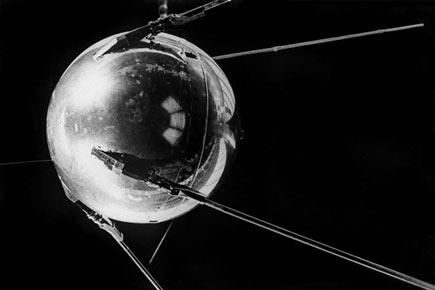The world's first artificial satellite Sputnik I, was launched by Russia from the Baikonur cosmodrome in Kazakhstan, today on, 04 October 1957. On this occasion, we present a selection of interesting facts about the Sputnik satellite

Sputnik 1 satellite, Space mission, Sputnik, 1957, Space race, Sputnik crisis, US and Russia
Russia launched Sputnik, the first-ever artificial satellite at the height of Cold War in 1957, leaving behind its rival United States.
The satellite was launched aboard a Soviet R-7 rocket from what is now the Baikonur space centre in Kazakhstan.
ADVERTISEMENT

The Sputnik 1. Pic/AFP
The satellite with regular 'beep-beep' radio signals for 22 days till its transmitter battery ran down orbited the Earth for 3 months, travelling around 60 million km before burning in atmosphere on re-entering on January 4, 1958.
The Sputnik launch coincided with the 102nd anniversary of the Wright brothers' first powered, controlled flight.
The Sputnik I was a 58 cm (23 in) diameter polished metal sphere, with four external radio antennas to broadcast radio pulses.
Sputnik itself provided scientists with valuable information. The density of the upper atmosphere could be deduced from its drag on the orbit, and the propagation of its radio signals gave information about the ionosphere.
The surprise success precipitated the American Sputnik crisis and triggered the Space Race, a part of the larger Cold War.
Sputnik 1 was launched during the International Geophysical Year from Site No.1/5, at the 5th Tyuratam range, in Kazakh SSR (now at the Baikonur Cosmodrome). The satellite travelled at about 29,000 kilometres per hour (18,000 mph; 8,100 m/s), taking 96.2 minutes to complete each orbit. It transmitted on 20.005 and 40.002 MHz[5] which were monitored by amateur radio operators throughout the world.[6] The signals continued for 22 days until the transmitter batteries ran out on 26 October 1957.
The control system of the Sputnik rocket was adjusted to an intended orbit of 223 km (139 mi) by 1,450 km (900 mi), with an orbital period of 101.5 min.
The trajectory was calculated earlier by Georgi Grechko,[52] using the USSR Academy of Sciences' mainframe computer.
On the first orbit the Telegraph Agency of the Soviet Union (TASS) transmitted: "As result of great, intense work of scientific institutes and design bureaus the first artificial Earth satellite has been built".
The chief constructor of Sputnik 1 at OKB-1 was M. S. Khomyakov.
The launch of Sputnik 1 inspired U.S. writer Herb Caen to coin the term "beatnik" in an article about the Beat Generation in the San Francisco Chronicle on 2 April 1958.
Sputnik 1 burned up on 4 January 1958, as it fell from orbit upon reentering Earth's atmosphere, after travelling about 70 million km (43.5 million miles) and spending 3 months in orbit.
 Subscribe today by clicking the link and stay updated with the latest news!" Click here!
Subscribe today by clicking the link and stay updated with the latest news!" Click here!






